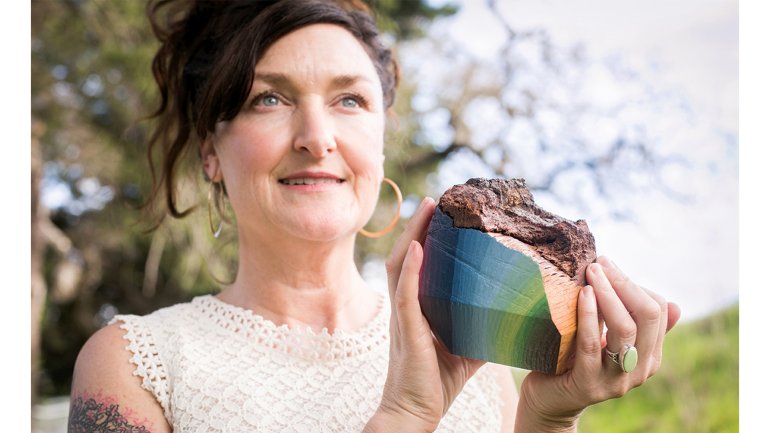Good Vibrations
Good Vibrations
Victoria Wagner’s love affair with wood started about four years ago, right after she was almost beamed by a chunk of the stuff falling from the sky.
Wagner, a painter, was having some diseased trees taken down on her property in the rural Northern California town of Occidental, and the airborne piece of Douglas fir gave her pause.
“I looked at it and thought, ‘Who are we, anyway, to cut down a tree? What right do we have? I need to do something with this piece of wood, to show it proper reverence.’ ”
So Wagner, who had previously used paper and canvas as her, well, canvas, secured the wood to her painting table with a vise, grabbed a handsaw, and started faceting the edges. Following organic growth patterns, she then painted the surfaces with gradient spectrums of color. “And suddenly, I had this little gem,” she says, describing the progenitor of her Woodrocks series. The sculptures, which she continues to make, are a mash-up of two of Wagner’s particular passions: color theory and the mysteries of nature.
Now an adjunct professor at California College of the Arts, Wagner, 48, received her BA in art in 1993 from Humboldt State University and her MFA from Mills College in 2001. Although she has lived amid the sea air and redwood forests for many years, Wagner carries with her a memory of the luminous hues of the high desert at the base of the Sierra Nevada mountains, where she grew up. With influences ranging from Albers (Josef and Anni), to Agnes Martin, Brice Marden, and her mentor Ron Nagle (whom she calls an “absolute color genius”), she has made a career of exploring subtle shifts of color across the spectrum.
Explains Wagner, “Colors in relation to each other create subtle vibrations that have a very profound effect on our emotions and psyches, on a totally non-verbal level.”
Wagner likes to pose herself color riddles, which she solves as she works in oil, gouache, and acrylic. “I’ll ponder a problem, like if I start with gold, what do I have to add incrementally to get to silver? Or when I look at wood, I might think this piece peaks forest green and lilac. What’s the track to get from one to the other? And they might not even hold two ends of the spectrum, so I might have to fold in another primary color to get back around.”
At the same time, Wagner has a mystic’s interest in the natural world, and credits two books for nurturing her current affinity for raw wood: Sir James Frazer’s Golden Bough: A Study in Magic and Religion, and The Secret Life of Plants by Peter Tompkins and Christopher Bird, a controversial treatise that examines sentience in plant life.
Soon after her original woodworking foray, Wagner invested in a proper set of tools and started finding salvaged hunks left in her driveway by friends, neighbors, and the local lumberjack. A major turning point came when she began to incorporate the areas damaged by the likes of termites, rot, bees, and the chain saw, rather than cutting them away. “I realized that the natural raw edge was actually a beautiful expression of the downed tree – not something to remove, but to celebrate.”
Although sculpture has been central to Wagner’s work of late, she has not abandoned her two-dimensional Spectral paintings. She recently began working on aluminum, using the reflective metal to pull the viewer into the flattened-out depictions of her Woodrocks. And Wagner painted directly onto wooden panels for People from Here (2015), an installation that refers to the Washoe people, who lived on a reservation near where she grew up. (“People from here” is the literal translation of washo in the indigenous language, which is all but extinct.)
Four color-field paintings are arranged as sandwich boards, a nod to the smoke shops that were the only business many Native Americans could sustain. Underneath the paint are sketches of baskets by artists including Dat So La Lee, a celebrated Washoe weaver from the 19th century and among the first to trade with European Americans. Sixty-one colored ceramic vessels (made by Wagner and CCA alumni) sit atop a walnut slab, where they represent the number of tribal territories in California before Europeans arrived. In the last week of the show at Yerba Buena Center for the Arts, the first 61 people to arrive were handed a plain white porcelain vessel to swap for one of the territory vessels, a symbolic reenactment of the whitewashing of the state.
For her current project, Wagner is gazing beyond the trees and up to the stars, with an homage to Edgar Mitchell, one of the astronauts on the Apollo 14 mission, who experienced a mystical epiphany out in space. She is pairing miniature components of the Apollo space station with ceramic “moon rocks” and color-gradient paintings based on images of the moon landing.
“Mitchell believed that the planet was part of an enormous and interconnected living system, and that consciousness was the deepest mystery of the universe,” Wagner explains. “And that, in a nutshell, is everything that I embrace.”

